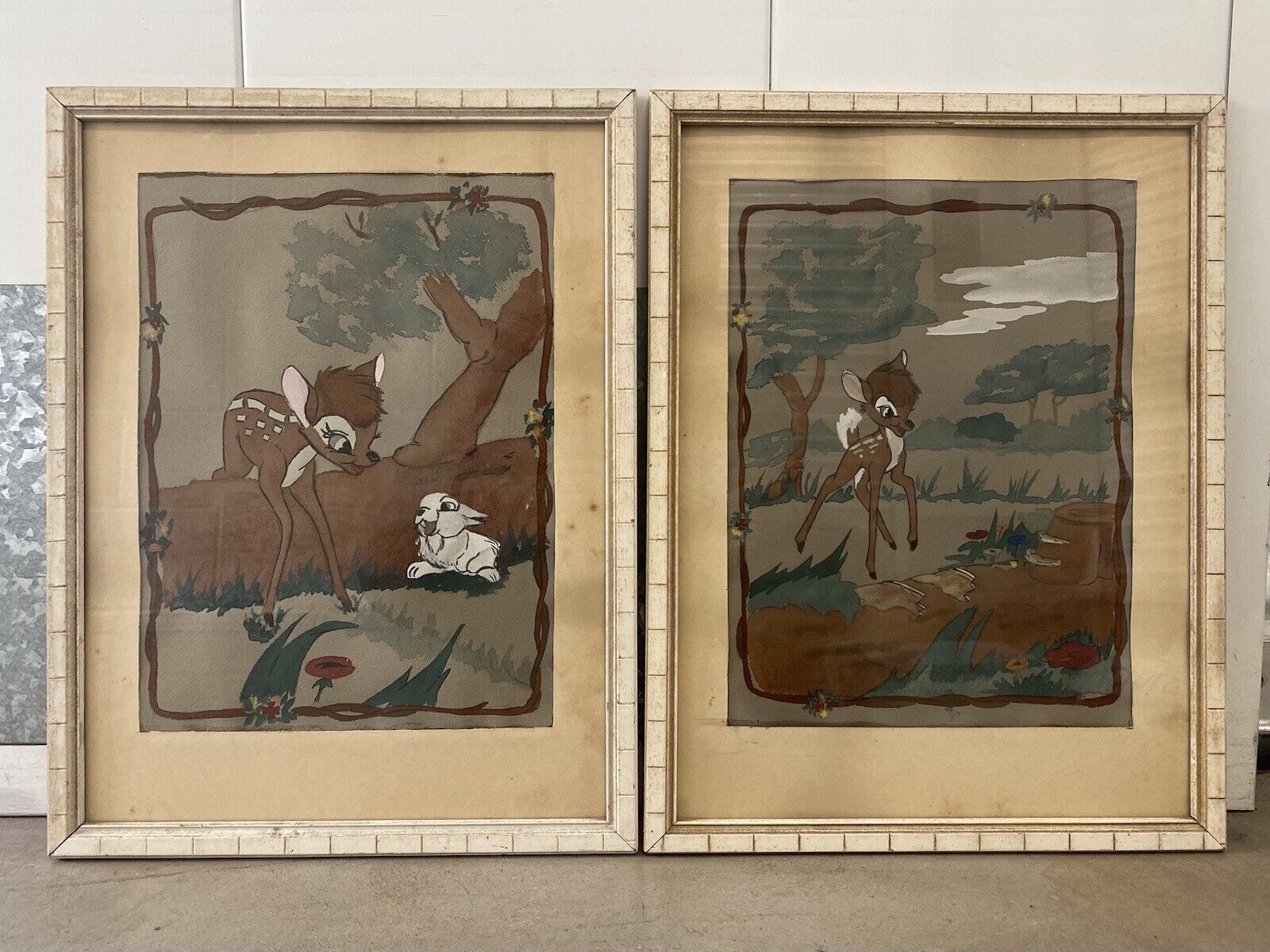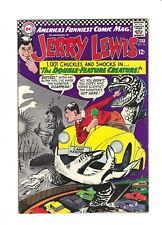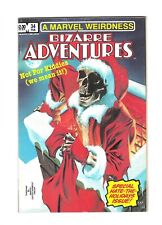When you click on links to various merchants on this site and make a purchase, this can result in this site earning a commission. Affiliate programs and affiliations include, but are not limited to, the eBay Partner Network.
This is a pair ofFine Antique Old Vintage Disney Art BAMBI Deer Thumper Paintings (2), likely painted in the 1940\'s, soon after the release of Walt Disney\'s Bambi (1942.) These painting are watercolor and oil or gouache on paper and depict two charming scenes from the film. The first painting on the left shows Bambi climbing over a log, while talking to his rabbit friend, Thumper. The second painting shows Bambi galivanting through the woods, with blooming wildflowers, trees and foliage in the surroundings. These paintings do not appear to be signed, but perhaps you recognize the artist or their work? I have not taken them out of the frame to examine them, and there may be a signature below the matting, or on the verso of the paintings themselves. I am not sure if these pieces were painted by a known Disney studio artist, but they are certainly well done. Each painting is approximately 13 x 17 inches (including frame.) Actual visible artwork is approximately 9 1/8 x 12 3/8 inches. Good condition for 80+ years of age and storage, with moderate scuffing, edge wear and soiling to the vintage 40\'s - 50\'s painted wood frames. Additionally, there is some moderate toning and speckles of soiling to the matting paper of each painting (please see photos.) Acquired from an old collection in Los Angeles County, California. If you like what you see, I encourage you to make an Offer. Please check out my other listings for more wonderful and unique artworks!
About this Artwork:
Bambiis a 1942 Americananimateddrama filmproduced byWalt Disney Productionsand released byRKO Radio Pictures. It is based on the 1923 novelBambi, a Life in the Woodsby Austrian author and hunterFelix Salten.The film was produced byWalt Disneyand directed byDavid Handand a team of sequence directors.
The main characters areBambi, awhite-tailed deer; his parents (the Great Prince of the forest and his unnamed mother); his friendsThumper(a pink-nosedrabbit); and Flower (askunk); and his childhood friend and future mate,Faline. In the original book, Bambi was aroe deer, a species native to Europe; but Disney decided to base the character on amule deerfromArrowhead, California.Illustrator Maurice \"Jake\" Day convinced Disney that the mule deer had large \"mule-like\" ears and were more common to western North America; but that thewhite-tail deerwas more recognized throughout America.
The film received threeAcademy Awardnominations:Best Sound(Sam Slyfield),Best Song(for \"Love Is a Song\" sung byDonald Novis) andOriginal Music Score.
In June 2008, theAmerican Film Institutepresented a list of its \"10 Top 10\"—the best ten films in each of ten classic American film genres—after polling over 1,500 people from the creative community.Bambiplaced third in animation.In December 2011, the film was added to theNational Film Registryof theLibrary of Congressas being \"culturally, historically and aesthetically significant\".
Plot
A doe gives birth to a male fawn namedBambi, who will one day take over the position of Great Prince of the Forest, who guards the woodland creatures. Bambi grows up very attached to his mother, with whom he spends most of his time. The fawn is befriended by an eager, energetic male rabbit namedThumper, who helps to teach him to walk and speak, a young male skunk he mistakenly calls \"Flower\" (who is so flattered, he keeps the name) and a female fawn named Faline. Curious and inquisitive, Bambi frequently asks about the world around him and is cautioned about the dangers of life as a forest creature by his loving mother. One day out in a meadow, Bambi briefly sees the Great Prince but does not realize that he is his father. As the Great Prince wanders uphill, he discovers the human hunter, named \"Man\" by all the animals, is coming and rushes down to the meadow to get everyone to safety. Bambi is briefly separated from his mother during that time but is escorted to her by the Great Prince as the three of them make it back in the forest just as Man fires his gun.
During Bambi\'s first winter, he and Thumper play in the snow while Flower hibernates. One day his mother takes him to find food when Man shows up again. As they run off, his mother is shot and killed by the hunter, leaving the little fawn mournful and alone. Taking pity on his abandoned son, the Great Prince leads Bambi home as he reveals to him that he is his father. Next year, Bambi has matured into a young stag, and his childhood friends have also entered young adulthood. They are warned of \"twitterpation\" by Friend Owl and that they will eventually fall in love, but the trio views the concept of romance with scorn. Thumper and Flower soon encounter their beautiful romantic counterparts and abandon their former thoughts on love. Bambi himself encounters Faline as a beautiful doe. Their courtship is quickly interrupted by a belligerent older stag named Ronno, who attempts to force Faline away from Bambi. Bambi successfully manages to defeat Ronno in battle and earn the rights to the doe\'s affections.
Bambi is awakened afterward by the smell of smoke; he follows it and discovers it leads to a hunter camp. His father warns Bambi that Man has returned with more hunters. Bambi is separated from Faline in the turmoil, but finds her cornered by Man\'s vicious hunting dogs, which he manages to ward off. Bambi escapes them and is shot by Man, but survives. Meanwhile, at the \"Man\'s\" camp, their campfire suddenly spreads into the forest, resulting in a wildfire from which the forest residents flee in fear. Bambi, his father, Faline, and the forest animals manage to reach shelter on a riverbank. The following spring, Faline gives birth to twins under Bambi\'s watchful eye as the new Great Prince of the Forest.
Development
In 1933,Sidney Franklin, a producer and director atMetro-Goldwyn-Mayer, purchased the film rights toFelix Salten\'s novelBambi, a Life in the Woods, intending to adapt it as alive-actionfilm. After years of experimentation, he eventually decided that it would be too difficult to make such a film and he sold the film rights toWalt Disneyin April 1937.Disney began work on crafting an animated adaptation immediately, intending it to be the company\'s second feature-length animated film and their first to be based on a specific, recent work.However, the original novel was written for an adult audience, and was considered too \"grim\" and \"somber\" for a regular light-hearted Disney film.The artists also discovered that it would be challenging to animate deer realistically.These difficulties resulted in Disney putting production on hold while the studio worked on several other projects.In 1938, Disney assigned Perce Pearce and Carl Fallberg to work on the film\'s storyboards, but attention was soon drawn away as the studio began working on Fantasia.Finally, on August 17, 1939, production onBambibegan in earnest, but progressed slowly owing to changes in the studio personnel, location, and methodology of handling animation at the time.
Writing
There were many interpretations of the story. As writer and animatorMel Shawrecalled:
The story ofBambihad a so many possibilities, you could go off on a million tangents. I remember one situation when Walt became involved with himself. He said \'Suppose we have Bambi step on an ant hill and we cut inside and see all the damage he\'s done to the ant civilization\'. We spent weeks and weeks developing the ants, and then all of a sudden we decided, you know, we\'re way off the story, this has got nothing to do with the story ofBambi. We also had a family of grasshoppers, and they get into a family squabble of this or that, and Bambi is watching all of this, and here\'s the big head of Bambi in the grasshoppers. And what\'s that got to do with the story, and this would go on many times.
Originally the film was intended to have six individual bunny characters, similar to the dwarfs inSnow White. However, Perce Pearce suggested that they could instead have five generic rabbits and one rabbit with a different color than the rest, with one tooth, would have a very distinct personality. This character later became known as Thumper.
There originally was a brief shot in the scene where Bambi\'s mother dies after jumping over a log and getting shot by a man. Larry Morey, however, felt the scene was too dramatic, and that it was emotional enough to justify having her death occur off screen. Walt Disney was also eager to show the man burned to death by his fire that he inadvertently started, but this was discarded when it was decided not to show the man at all. There was also a scene involving two autumn leaves conversing like an old married couple before parting ways and falling to the ground, but Disney found that talking flora did not work in the context of the film, and instead a visual metaphor of two realistic leaves falling to the ground was used instead.Disney and his story team also developed the characters consisting of a squirrel and a chipmunk that were to be a comic duo reminiscent ofLaurel and Hardy. However, after years of experimentation, Walt felt that the story should focus on the three principal characters: Bambi, Thumper and Flower.The squirrel and chipmunk make only brief appearances in the final film.
The writing was completed in July 1940, by which time the film\'s budget had increased to $858,000.
Animation
Although the animators had animated deer inSnow White, they were animated, in the words ofEric Larson, \"like big flour sacks\".Disney wanted the animals inBambito be more realistic and expressive than those inSnow White. He had Rico LeBrun, a painter of animals, come and lecture to the animators on the structure and movement of animals.The animators visited theLos Angeles Zooand Disney set up a small zoo at the studio with animals such as rabbits, ducks, owls, and skunks, and a pair of fawns named Bambi and Faline so that the artists could see first-hand the movement of these animals.LeBrun\'s sketches depicted realistic animals, but as characters they lacked personality.Marc Daviscreated the final design of Bambi by incorporating LeBrun\'s realistic study of deer anatomy but exaggerating the character\'s face by making his proportions baby-like (short snout, big eyes, etc.).Although there were no humans inBambi,live-actionfootage of humans was used for one scene: actressJane RandolphandIce CapadesstarDonna Atwoodacted as live-action references for the scene where Bambi and Thumper are on the icy pond.The animators learned a lot about animals during the film\'s production, giving them a broader spectrum of animation styles to use in future projects.
The backgrounds for the film were inspired by the Eastern American woodlands. One of the earliest and best-known artists for the Disney studio,Maurice \"Jake\" Day, spent several weeks in the Vermont and Maine forests, sketching and photographing deer, fawns, and the surrounding wilderness areas.However, his first sketches were too \"busy\" as the eye did not know where to focus.Tyrus Wong, a Chinese animator, showed Day some of his impressionistic paintings of a forest. Day liked the paintings and appointed him art director of the film.Wong\'s backgrounds were revolutionary since they had more detail around the center and less around the edges, thus leading a viewer\'s eye to the characters.
Due toWorld War II, which began in Europe in 1939,PinocchioandFantasiafailed at the box office. Facing financial difficulty, Disney was forced to cut 12 minutes from the film before final animation to save production costs.
Critical reaction
At the time of the film\'s release,Bambireceived mixed reviews from the critics, mainly because of the lack of fantasy elements in the film and objection towards a dramatic story of animals and their struggle to survive in the woods and avoid the threat of humans.The New York Timesclaimed that \"In the search for perfection, Mr. Disney has come perilously close to tossing away his whole world of cartoon fantasy.\"Manny FarberofThe New Republicwrote that \"Bambi is interesting because it\'s the first one that\'s been entirely unpleasant…Mickeywouldn\'t be caught dead in this.\"
Farber added that \"In an attempt to ape the trumped-up realism of flesh and blood movies, he has given up fantasy, which was pretty much the magic element.\" Even Disney\'s daughterDianecomplained, saying that Bambi\'s mother did not need to die. When Walt claimed that he was only following the book, Diane protested, saying that he had taken other liberties before, and that Walt Disney could do whatever he wanted.
Today, however,Bambiis viewed much more favorably. On the review aggregator websiteRotten Tomatoes, the film has an approval rating of 91% based on 53 reviews with an average rating of 8.3/10. The website consensus reads: \"Elegantly animated and deeply touching,Bambiis an enduring, endearing, and moving Disney classic.\"Metacritic, which uses aweighted average, assigned the film a score of 91 out of 100, based on 16 critics, indicating \"universal acclaim\".Critics Mick Martin and Marsha Porter call the film \"the crowning achievement of Walt Disney\'s animation studio\".English film historianLeslie Halliwellwrote thatBambiwas \"one of Disney\'s most memorable and brilliant achievements with a great comic character in Thumper and a climactic forest fire sequence that is genuinely thrilling.\" He concluded that it was \"a triumph of the animator\'s arts\".
Box office
The film was released duringWorld War IIand did not perform as well as hoped.Roy O. Disneysent a telegram to his brother Walt after the New York opening of the film that read: \"Fell short of our holdover figure by $4,000. Just came from Music Hall. Unable to make any deal to stay third week ... Night business is our problem.\"The film earned RKOtheatrical rentalsof $1,270,000 in the United States and Canada in its initial release.[52][53]
Disney lacked access to much of the European market during the war, however, the film earned rentals of $1,685,000 internationally for an initial worldwide total of $2,955,000, Disney\'s third highest, behind Snow White and the Seven Dwarves(1937) with $7.8 million and Pinocchio(1940) with $3.2 million.
In its first reissue in the United States in 1947, the film earned additional domestic rentals of $900,000 but did much better 10 years later, more than doubling the domestic rental total with a further $2.5 milliontaking its total domestic rental earnings to $4.7 million.
The film earned $14 million in domestic rentals from its reissues in 1966 and 1975 giving it a total domestic rental of $18,735,000, which equates to a gross of around $40 million.In 1982, it grossed another $23 million in the United States and Canada and in 1988, a further $39 million, taking its total in the United States and Canada to $102 million,making it (at the time) the secondhighest-grossing animated movie of all-timeafterSnow White and the Seven Dwarfs.With grosses from international reissues, the film has a worldwide gross of $267 million.
Legacy
The off-screen villain \"Man\" has been placed No. 20 onAFI\'s List of Heroes and Villains.
Some critics have cited parallels between Frank Churchill\'s theme music for \"Man\" (which consisted of three simple notes) andJohn Williams\'s theme music inJaws(which consists of two notes).
Paul McCartneyhas credited the shooting death of Bambi\'s mother for his initial interest inanimal rights.
Soon after the film\'s release, Walt Disney allowed his characters to appear in fire prevention public service campaigns. However, Bambi was only loaned to the government for a year, so a new symbol was needed, leading to the creation ofSmokey Bear. Bambi and his mother also make a cameo appearance in the satirical 1955 Donald Duck short No Hunting: drinking from a forest stream, the deer are startled by a sudden trickle of beer cans and other debris, and Bambi\'s mother tells him, \"Man is in the forest. Let\'s dig out.\"
In 2006, theAd Council, in partnership with theUnited States Forest Service, started a series ofPublic Service Announcementsthat feature footage fromBambiandBambi IIforwildfireprevention. During the ads, as theBambifootage is shown, the screen will momentarily fade into black with the text \"Don\'t let our forests...become once upon a time\", and usually (but not always) ending the ads with Bambi\'s line \"Mother, what we gonna do today?\" followed bySmokey Bearsaying \"Only you can prevent wildfires\" as the Smokey logo is shown on the screen.Bambi had previously been the Forest Service\'s advertising icon beginning in 1942 but was only allowed by Disney to use the character for a year.
In December 2011,Bambiwas among the films selected for preservation in the Library of Congress\' National Film Registry. In its induction, the Registry said that the film was one of Walt Disney\'s favorites and that it has been \"recognized for its eloquent message of nature conservation.\"
Characters of the film appear in several other Disney media, such as guest appearances in the animated television seriesHouse of Mouse, Bambi being a character to summon in the video gameKingdom Heartsand its sequelKingdom Hearts: Chain of Memories,and Bambi, Thumper, Flower, Faline and Great Prince of the Forest being playable characters inDisney Magic Kingdoms.
On December 17, 2018, a prison sentence passed against a man, in what is considered the biggest deer poaching case in Missouri history, contained the stipulation that the prisoner must view the film at least once each month during his one-year prison sentence.











